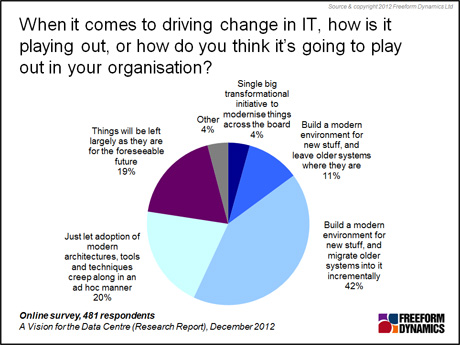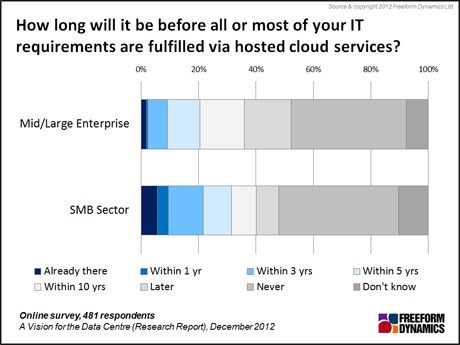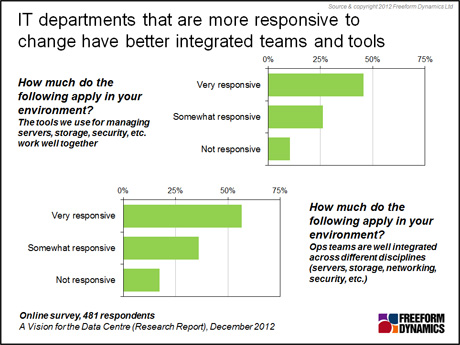By Andrew Buss
Most IT departments today recognise that things could be run much more effectively and efficiently, given a nirvana with free reign of budget, time and people, not to mention a stable and predictable business.
With freedom from the traditional restraints, it is not surprising that in a recent Freeform Dynamics survey most respondents were in favour of a very dynamic, integrated and service-led approach to IT.
Back in the real world though, most IT organisations are quite a long way away from the ideal vision, as they have many different competing priorities to juggle and compromises to make.
Yet when it comes to the matter of evolving IT to meet changing requirements, all too often the message from many IT vendors is centred around the concept ‘IT is not working’, requiring sweeping away the old and implementing major change and re-architecting everything.
The good news for the vendors is there is a market for this message, but it is limited to a very small niche that is building advanced requirements from scratch or where IT is the revenue-generating centre of the business.
For the rest though, a more measured approach is in order where gradual modernisation can help deliver new requirements more effectively, while dragging the existing workloads along on its coat-tails if possible (Figure 1).

Figure 1
When it comes to developing this enhanced IT service delivery capability, there are some complex decisions to be made. One of these is the balance between evolving and optimising the internal IT infrastructure or using external, third party hosted or cloud services that are geared up to provide many of the attributes and characteristics that a pre-existing IT environment may struggle to provide.
The messaging from some of the leading, or at least the noisiest, cloud vendors would have us believe that investing in infrastructure is a dead end and that the shared economics of cloud are a ‘no-brainer’. The reality is that very few companies – particularly the larger and more established ones – buy into this vision, at least for the foreseeable future (Figure 2).

Figure 2
This is not to say that making use of external cloud services is not going to happen. All indications are that public and hybrid private/public cloud services are seen as very useful and convenient if not particularly strategic.
Many companies are happy to buy numerous SaaS applications, and to make increasing use of IaaS as well. What they are not looking to do is make this the main or default way of developing and delivering IT.
The takeaway here is that for most companies, Cloud is not a replacement for what they are running today, but another useful and complementary way to deliver IT. The most important aspect is to understand the services needs of the business and evaluate and select the most appropriate way to deliver it.
With internal IT remaining very important and not going away any time soon, the priority for many companies will be on-going evolution and optimisation.
Investing in new equipment can help, particularly to boost pain points in performance or capacity, but technology on its own can only deliver so much if it is used in the same way as before.
For IT to really deliver value, it needs to become more adaptable, flexible and responsive to business needs, yet this is the area where most IT departments still struggle to deliver and where external cloud providers look to claim an advantage.
Time and again we see that the most responsive– and usually also the most business aligned – IT departments are those that look beyond the base technology and work at integrating the teams and management tools so that the various components work well together (Figure 3).

Figure 3
Realising that this lack of integration is a real issue can be hard. Many systems are pretty well optimised in their own right so there doesn’t appear to be an inherent problem with the setup. It is often only when stepping back and taking a fresh look at how independent systems interact in an end-to-end service, and how they make change difficult, that the realisation tends to dawn.
Making the case for integrating existing systems and infrastructure that are performing well when budgets are tight and demands for new applications and services are coming thick and fast is hard. Yet without taking the tough action, time, effort and money will continue to be spent on patching things up rather than improving things to deliver more of what the business needs.
CLICK HERE TO VIEW ORIGINAL PUBLISHED ON

Content Contributors: Andrew Buss